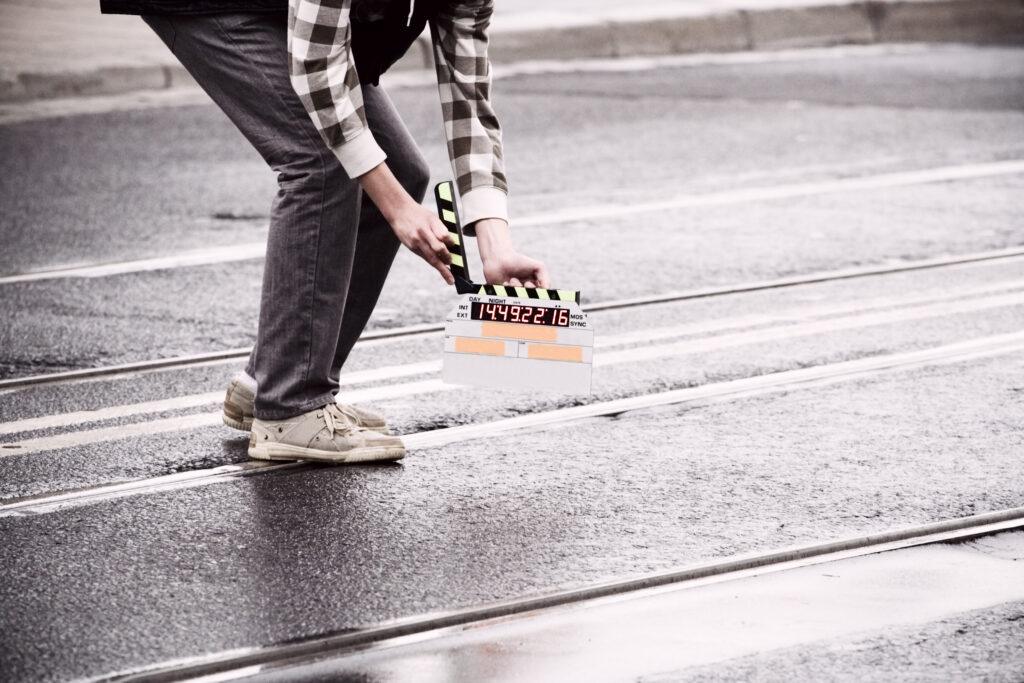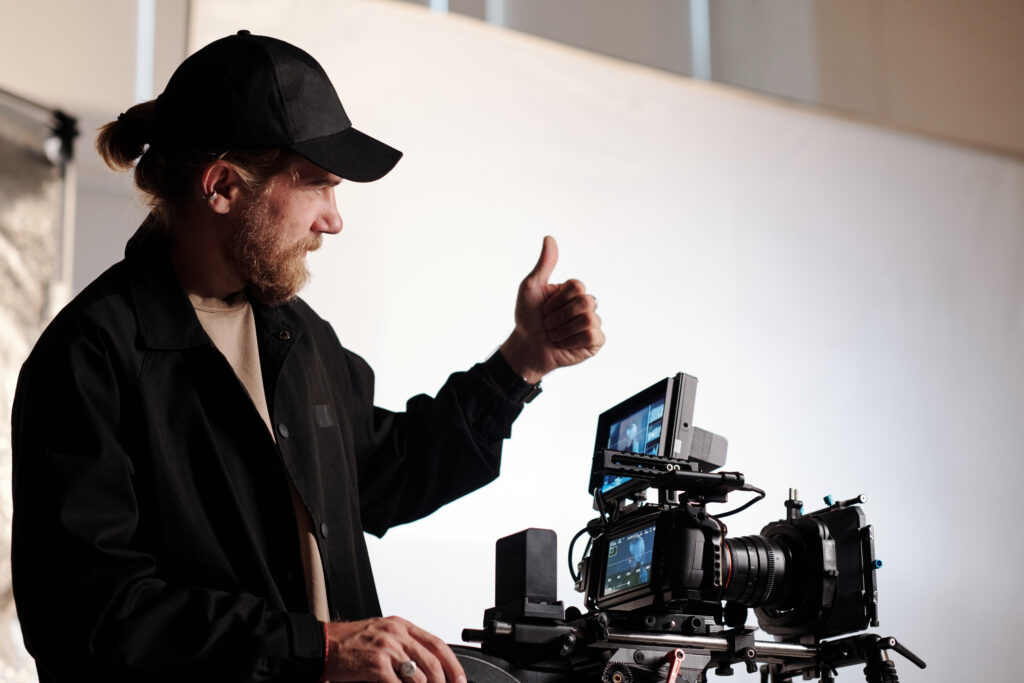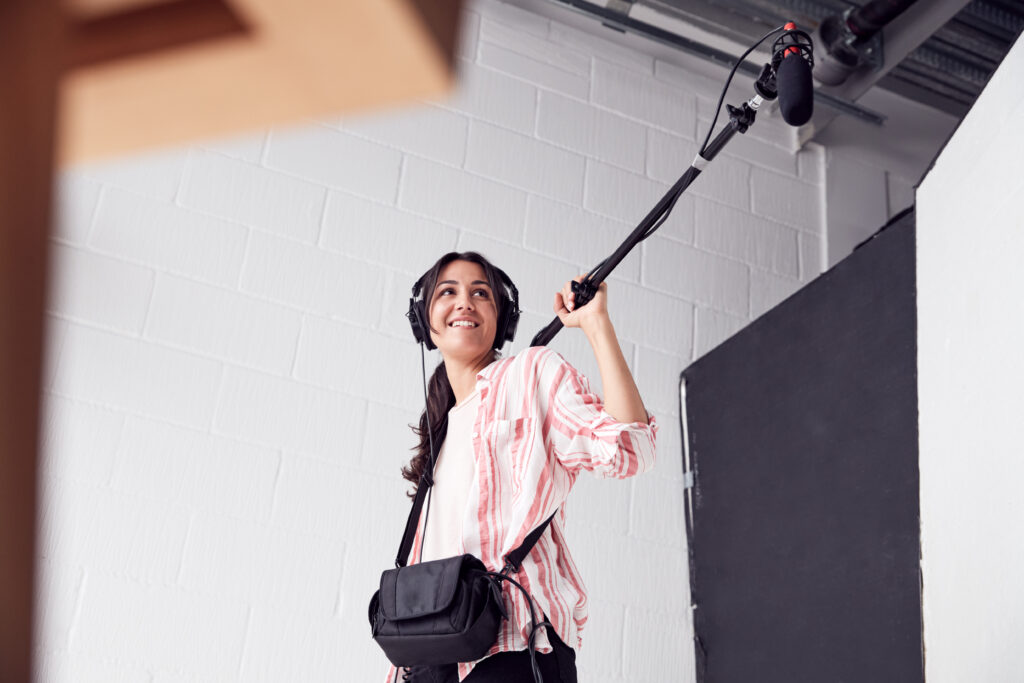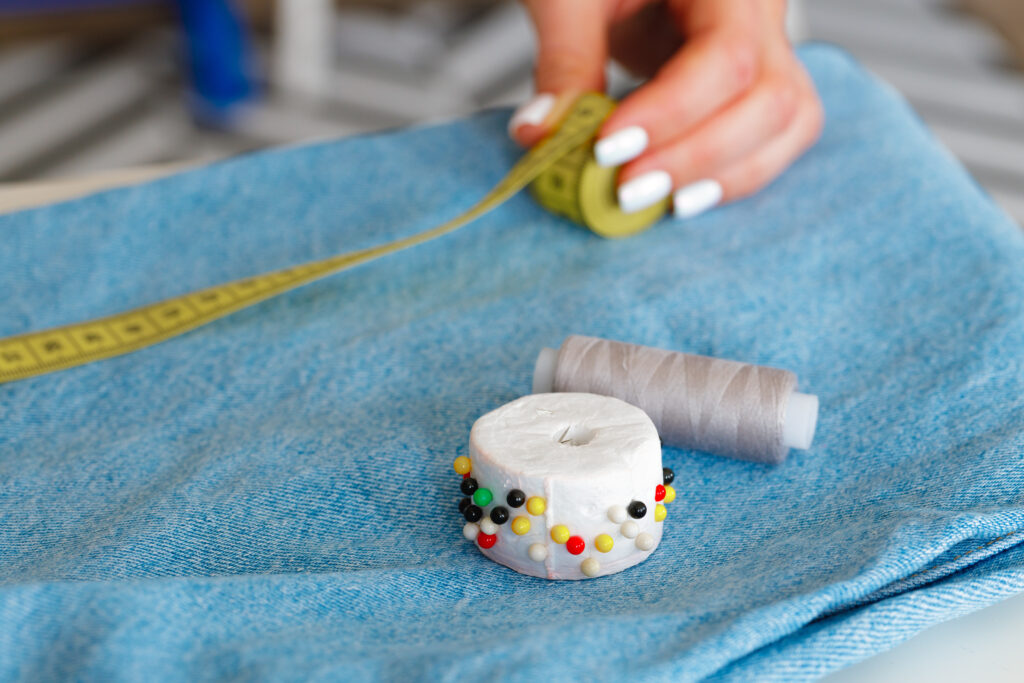
Pre-production serves as more than just your video’s blueprint – it’s your video’s bedrock, foundation, and scaffolding. When your pre-production process is strong and structured, the video shoot falls into place and can withstand unforeseen challenges.
But what exactly does pre-production entail, and how does it help ensure you have adequate time and budget to bring your vision to life during video production? In this blog, we’ll take a deep dive into the pre-production process including creating storyboards, casting talent, finalizing schedules, and more. We’ll also discuss what to do when you only have a limited timeframe for pre-production.
When does pre-production begin?
As soon as you have a final concept or script for your video, it’s time to start pre-production. While you can do some planning before finalizing your concept, we’d only recommend researching the general feasibility of your ideas. Pre-production is complicated enough without shifting roles and locations.
During pre-production, you’ll map out every aspect of production and even start making preparations for post-production. Pre-production includes determining your budget, hiring a crew, renting or purchasing equipment, casting, location scouting, wardrobe and prop design, storyboarding, rehearsals, and finalizing a shooting schedule.
Not every project requires every step, and some may necessitate unique ones like choreography, set construction, or stunt safety planning. But you should begin each project by determining a budget.
How do you create a budget?
It’s nearly impossible to plan your shoot without an initial budget. You can’t hire crews, select locations, or acquire props. As pre-production progresses, you may find you need less or more money than anticipated, and stakeholders might join or exit the project. But to start, there are three approaches you can take when budgeting.
The first approach is the simplest: establish an overall spending limit. As you hire crew, talent, and find the right shooting locations, keep track of costs. Make sure to first allocate funds toward the most important elements of filming so that when you’re nearing your limit, you compromise in the right places.
The second approach requires a bit more planning and industry knowledge but is less risky. Set budget caps for cast, crew, locations, and department spending. Through this strategy, you ensure you’ll have enough money to fund the core elements of your production. However, you may need to make compromises in multiple areas to adhere to your spending constraints. You also need a general sense of costs and rates for this strategy to be worthwhile. For example, Indigo’s research has found that above-the-line talent, such as the director, producer, and key actors, adds up on average to between 16% and 26% of total costs.
Finally, you can look into the pricing of your must-haves and wants. Add up the total bill and make cuts if it’s beyond what you can spend.
Video shoots can end up costing more than initially planned. Causes include overtime pay when days run long, reshoots, and pre-production oversights such as under-budgeting for things like meals and craft services. This is why you should always keep some budget in reserve for over-runs. You should also track spending in a spreadsheet, and keep receipts from all purchases.
At Indigo Productions, we make budgeting easy. We can provide an itemized quote with competitive rates or review your desired budget and maximize its potential. Of course, the final choice of how your money is spent is up to you, but we’ll give you expert recommendations and guidance on where you can cut corners without sacrificing quality, and where you can’t.
How do you hire a crew?

After you’ve established your budget, it’s time to lock in your crew. Once you have a crew, it’s easier to determine what equipment you’ll need and you’ll have a bigger team to help plan the details of the shoot.
If you have go-to collaborators, hiring a crew is easy. Reach out to them with the details of the shoot to find out if they’re available. It’s generally a good idea to work with a crew that has experience working together – a well oiled machine.
If you don’t already have industry contacts, you could consider exploring Facebook groups… but in all honesty, it will be a lot easier to hire a highly experienced video production company that provides one-stop-shopping.
Not every production needs a large crew, and budget is a major factor on crew size. To help you determine what roles you’ll need to fill, we’ve listed the most common film positions along with brief descriptions.
Producers
Producers shine during pre-production. They help with logistics including getting contracts signed, acquiring permits, tracking budgets, and following up on a million details. Producers continue to work during production and post-production but a huge part of their effort happens before the shoot.
Director
The director is the key visionary for the film. The director takes responsibility for the performances, the camera angles, the general aesthetic, the pacing, and the edit. It’s important to hire a great director with a strong vision early on.
1st Assistant Director
The 1st AD takes the director’s vision and translates it into a shooting schedule. On set, they manage extras, keep the crew on time, and consult with departments to make sure they have everything they need.

Director of Photography
The DP handles the visual look of the film, from the choice of camera to its movement, angles, and lighting. They work closely with the director to develop a visual language and shot list.
1st Assistant Camera
The 1st AC collaborates with the DP to help operate the camera. They are usually in charge of pulling focus.
2nd Assistant Camera
The 2nd AC ensures that the DP and 1st AC have what they need to operate. This includes providing charged batteries and other essential equipment. The 2nd AC is also in charge of the slate.
Gaffer
The gaffer takes direction from the DP regarding the overall lighting scheme and translates it into a practical lighting setup.
Grip
Grips work with the gaffer to build and move the lights and other heavy or specialized equipment.

Sound Mixer / Recordist
The sound mixer / recordist oversees the sound department. They bring various microphones such as lavaliers and shotgun mics, and mic the on-camera talent. Their mics are fed into a recorder that they adjust to ensure optimal sound quality.
Boom Operator
The boom op carries the boom to record sound from talent. It may seem like a simple job, but there’s a lot to keep track of. Boom ops optimize mic distance to the subject without getting the boom in view of the camera. They also have to know the script (if there is one) so that they can be ready to boom the correct cast member. And holding a boom pole for long periods of time is more strenuous than you’d expect!
Digital Imaging Technician
The DIT copies the footage from the camera cards and makes backups. They can playback previous clips for the director or DP, and can even prep the footage with an initial color grade.
Script Supervisor
The script supervisor pays careful attention to performances and continuity, confirming the lines are read according to the script and that there aren’t discrepancies between shots. They can work with the 1st AD to determine what coverage can be cut due to time constraints, and what still needs to be filmed.
Production Assistants
PAs help with all the miscellaneous tasks on set. From getting coffee to moving tables, they are the unsung heroes of production.
Indigo Productions has a large international team of video professionals that will do a stellar on your project. No matter the position, we have the crew with the right experience for the job, and we’ll assemble a superstar team for you.
How do you rent or purchase equipment?
If you’re an end client it doesn’t make sense for you to purchase equipment – unless you’re setting up a mini-studio and plan to use the equipment over and over.
Professional production companies generally provide their own equipment. The crew will have complete familiarity with the equipment, so this is the best route.
Certain specialized equipment may need to be sub-rented. Equipment such as the highest-end cameras, large lighting packages, and high-end lenses are usually rented due to their prohibitive costs. While there are many websites offering equipment rentals, we recommend using a professional video production company or rental house. They specialize in video equipment rentals and guarantee their equipment is well maintained. They will typically be a one-stop shop for a wide variety of equipment. If you need long-term rentals, ask if they can offer a discount. And make sure you have insurance to cover accidental damage. You will probably be required to have it in order to rent.
When you hire Indigo Productions to produce your video, we’ll identify exactly what you need for your shoot and provide it from our existing inventory of cutting-edge tech. And if you need equipment we don’t have, we’ll take advantage of our pre-existing relationships with rental houses and crews to acquire it for the lowest cost.
How do you cast your film?

The casting of actors is among the most important steps in the pre-production process. Audiences are distracted by unconvincing performances in even the most technically proficient videos, while videos with technical shortcomings can still be very effective if the acting is great. Additionally, key pre-production steps such as finalizing wardrobe can’t be completed until you have chosen your cast.
Casting isn’t easy. You don’t just need a great actor, but an actor who is right for the role and fits with your intended mood and goals. Thankfully, there are more ways than ever to connect with promising talent.
Talent Agencies
If you don’t have the time or resources to review hundreds of auditions yourself, you can reach out to a talent agency. Talent agencies have a long history of connecting filmmakers with the right cast members, and have their own directory of vetted professionals. Simply send over a description of the role, lines for an audition, and perhaps a budget range per day of filming, and let your agency contact handle the rest. The advantage of this approach is its simplicity and the specialized knowledge and roster the agency can provide. The limitations are that hiring an actor through talent agencies can be more expensive and the talent agency may not represent the right actor for your video.
Casting Calls
If you decide to handle casting yourself, there are various platforms you can use to put out a casting call, one of the most popular of which is Backstage. Specify pay, physical characteristics, age, and any other details you can imagine. View the headshots and reels of interested candidates, and invite those who are qualified to audition. Auditions can be held virtually, via self-tape, or in person. While we recommend meeting with your top choices in person, virtual auditions are now commonplace.
When picking line readings for the audition, there is really only one rule: Choose the lines or scenes that will make it most clear to you if the actor is right for the part. This might mean giving them lines from another project entirely, or simply judging their physical performance. Regardless of the lines your actors read, work with them during their auditions to develop a rapport, and don’t be afraid to change up your original audition plan to bring out the best in a performance.
Finally, be absolutely certain that your top choice can make their scheduled shooting dates and that they have some flexibility to shoot on neighboring days. It is a great disappointment to recast due to an unanticipated scheduling conflict. These conflicts can leave you with an improperly cast role, or worse, significant disruptions to your shooting schedule.
VO Casting
Casting for voice-overs is a bit different than casting a live-action role. There’s no need to focus on headshots or other physical characteristics, just the timbre and range of a voice. Websites like Voice123 allow you to specify your needs and connect with voice talent instantly. You can listen to a talent’s different specialty voices and even have them record scratch tracks to see how their performance works with your storyboard or animatic. When casting a voice, there is often more at play than simply getting the best performance. In corporate videos, VO might be used to represent the voice of the brand. If you are casting a voice that will be used across multiple videos or for the duration of a campaign, be sure to consult the relevant creative teams and executives.
Animals
If casting for voiceover is a bit different than casting for live-action, then casting animals is VERY different! While casting your own or a friend’s pet may be tempting, we wouldn’t recommend it for anything more than the smallest of cameos. There are working animal actors in the film industry, with different training and abilities. They have handlers skilled at securing consistent performances and agents who represent them. When choosing the right animal for your film, consider if their handler is easy to work with, if they can do the tasks required by the role, their previous credits / experience, and their appearance. While animals are always unpredictable, and you can’t guarantee their cooperation, cast an animal that will give your shoot the best chance at avoiding significant disruptions. And make sure your schedule builds in extra time to get the right animal performance. At Indigo, we’ve worked with animals on multiple occasions, including in our series of commercials for PetMeds. See the video below for the type of performance you can get when you cast the right animal!
Usage Rights and Releases
Always agree upon usage rights and releases with your actors and other on-camera talent up front. When coming to terms, lay out the platforms you will use for distribution as well as the duration of the agreement. Platforms include online, social media, linear television, non-linear television, and more. Don’t forget about clearing rights for on-set photography and the use of video stills in print or digital media. Different platforms and term durations command different rates. Union actors also have mandatory minimum rates depending on your production’s scale and distribution plans. Without getting a release signed with clear terms, your video can end up in limbo, unable to be distributed without a huge payout or risking a lawsuit. When you discuss terms up front and explain budget limitations and needs, you’ll find talent is generally understanding.
Indigo Productions has worked with a wide variety of talent agencies and has found the right cast members for shoots ranging from fashion showcases to comedy videos. We are constantly auditioning for different projects, and have streamlined the approach so that we do the bulk of the work and present you with only the best options.
How do you find shooting locations?

The locations you choose for your project make up that project’s world. There are obvious considerations such as the location’s look and how it fits with your original vision. However, there are also practical concerns. Consider if the location has enough room to stage your scenes, its relationship with natural light, if there is enough space for crew and equipment, what angles are possible, and if there is a bathroom and other important facilities nearby. You’ll also want to think about how the location is at different times of day, not just in terms of light but also in terms of noise and interruptions from the public.
Your locations should be cohesive and seem like they occupy the same world. To achieve this, you may have to stitch together multiple shooting locations to represent a single place. For example, you might film the interiors of a house and the exterior porch on completely different sides of town.
Locations can be greatly modified through set design and lighting. If you have a large budget, you might choose a more practical location that doesn’t completely fit your vision but that you can transform. If your budget is limited, you’ll want to choose a location that already has any vital characteristics built in.
Finding the right location is easier said than done. While you can browse locations online, the best location for your film may not be listed and you’ll ultimately have to visit the locations in person. Location scouts specialize in finding locations for your film, video or commercial. They have vast knowledge of a city’s architecture and are adept at reaching out and negotiating with homeowners or businesses that may not have ever imagined renting out their space for a film shoot.
Permits and Certificates of Insurance
If you are shooting on public property, you’ll probably need a permit. Every city or town has a different procedure for applying for permits and there may be fees to obtain them. Depending on the type of shoot you may be required to have law enforcement on site, and to notify neighbors. It’s possible to get away with filming without a permit if you have a small crew – but this can be risky. The worst thing that can happen to a shoot is being shut down. You’ll still have to pay the cast and crew for the full day, and you’ll be hopelessly behind schedule.
In cities like New York, you need certificates of insurance to film in most buildings. At minimum, you should be insured for 1 million dollars. Don’t show up to your shoot only to not be let in the building. Confirm you are good to go with the building manager well in advance.
Indigo Productions has filmed all over the globe, and we’re fully insured to shoot in almost any building. We know what makes a shooting location ideal, and what problems to keep in mind. By partnering with Indigo, you can tap into our directory of proven locales. We can also find locations that fit specific requirements and film or photograph them if you cannot be there in person. Finally, we’ll negotiate a contract for using the locations.
How do you design wardrobes, props, and sets?

Once you’ve established your cast and locations you can finalize your wardrobe, props, and set design. Each of these crafts requires careful planning and experience.
With large budgets, you can create concept art, hand-stitch costumes, and build unique props which you can place in previsualized versions of your shooting locations. You can also create duplicates of costumes and props for different scenarios and in case of damage to the original.
With a smaller budget, focus on acquiring existing outfits and props. You can modify them to better suit your film, and it will be cheaper than creating from scratch. You should also consult with cast and crew to see if they have clothing or items that fit your video and that they are willing to supply.
From costumes for humans to matching outfits for pets, we’ve customized wardrobes and props for many of our projects. Watch this playful ad for PetMeds for an example:
Why should you create storyboards and hold rehearsals?

Storyboards are sketches of the shots you plan to get. They sometimes have arrows to indicate movement, and can also be stitched together into animatics – videos that time out your storyboards with placeholder sound and dialogue. Storyboards are essential for complicated shoots, like action scenes, but can be helpful for any production. They provide peace of mind that the final edit will flow, and they encourage you to put more thought into your shooting strategy. Storyboards are not replicated one-to-one on set, but provide a great structure to start from. If you know your shooting location, you can even build a digital version in 3D software and input lens and camera information to get the most accurate storyboard possible.
Storyboards are how you plan for your camera on shoot day, but rehearsals are how you prepare your actors. By rehearsing, you work out performance details as well as blocking and staging in advance. You can rehearse anywhere, but you may want to lay tape on the floor to represent the layout of your location. With great rehearsals, shoot day is about the execution of a well-laid-out plan rather than a scramble for ideas. And by getting what you need efficiently, you’ll give yourself time to experiment with alternative choices and can explore sudden inspirations.
Translating ideas into a visual language takes talent and experience. Indigo Productions can storyboard your project, bringing innovative and cinematic ideas that won’t sacrifice the shoot’s efficiency. We are also happy to schedule rehearsals between our directors and talent in advance of a shoot.
How do you finalize a schedule and shot list?
Shot lists and schedules are inherently entwined. You can’t create a schedule until you know what shots you need, and how long each shot will take to set up and shoot. To create a schedule, the producer, director, 1st AD, and DP must closely collaborate. It’s best to schedule scenes that take place in the same location together. You’ll also want to shoot must-have shots first, and leave nice-to-haves for the end in case you run short on time.
If you have union members on your shoot, you will have to take into consideration union regulations. This includes meal breaks and maximum hours. If you are moving between different locations, you must account for the laborious process of a company move. Moving in and out of sets takes longer than anticipated and turnaround times will vary depending on crew size and equipment. Sometimes cramming in more than can comfortably fit in one day can’t be helped, but whenever possible add ten to fifteen extra minutes to your estimates.
Call sheets are sent out the day before a shoot and include the shooting location, schedule, parking instructions, contact information, and other important details such as the nearest hospital. They tell the crew and cast who is needed and when to arrive. Never schedule a call time for exactly when you need a crew member or talent, always have them arrive an hour or two earlier.
When you work with Indigo Productions, we’ll handle the call sheet and schedule. We carefully plan cost-effective shoots by scheduling crew and talent for as long as we need them but not longer. And we are skilled at shifting gears to account for unanticipated circumstances.
How do you do pre-production under time constraints?

As you’ve read, pre-production is complex. Unfortunately, we don’t always have the luxury of time. While, according to our analysis of past video productions, pre-production on feature films takes an average of 146 days, corporate shoots may spring up with little notice. When you don’t have enough time for complete and rigorous pre-production, focus on the steps that are most relevant to your project. For example, a rush project may not have large wardrobe or prop needs. But every project will require you to source crew and equipment.
Another great option is to contact a video production company like Indigo Productions. Professional video production companies have the experience, knowledge, workflow, crew, equipment, and contacts to swiftly get a production up and running. They’ll know exactly what to prioritize and have a built-in team that can simultaneously cover your pre-production tasks. Experienced video production companies are your best partner whether or not you have a lot of time to prepare for a shoot.
Contact Indigo Productions
Pre-production is a rigorous process, but an essential one. We hope this blog has demystified its steps, and that you learned some helpful tips to apply to your video productions. If you have any questions, feel free to reach out to us at www.indigoprod.com or call us at 212-765-5224. For more information about the video production process, we’ve written this blog. And if you have an upcoming shoot, we’re happy to provide pre-production services or full-service coverage of pre-production through post-production.